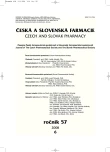Determination of metoprolol and its metabolite α-hydroxymetoprolol in serum by HPLC method with fluorescence detection
Authors:
I. Peřinová; J. Ďuricová; H. Brozmanová; I. Kacířová; M. Grundmann
Authors‘ workplace:
Ostravská univerzita Ostrava, Ústav klinické farmakologie FN a Zdravotně-sociální fakulty
Published in:
Čes. slov. Farm., 2008; 57, 254-259
Category:
Original Articles
Overview
High-performance liquid chromatography method has been developed with a view of its future use in the phenotyping of CYP2D6 enzyme by metoprolol as a probe drug. Metoprolol, α‑hydroxymetoprolol and the internal standard nadolol were extracted from serum with dichloromethane alkalinized with 1 mol/l NaOH. Chromatographic separations were performed on the reversed-phase column SupercosilTM LC-18 (15 cm × 3 mm, 5 μm) with the mobile phase containing acetonitril : methanol : water : triethylamine (15 : 5 : 80 : 0.1, pH 3.0) at a flow rate of 0.7 ml/min. Fluorescence detection (FL) was made at 230 nm (excitation) and 300 nm (emission). The total analysis time was 12 min. The retention time for α-hydroxymetoprolol, nadolol and metoprolol were 2.04, 3.02 and 9.04 min, respectively. The intra-assay and inter-assay precisions (coefficients of variation) were less than 7.2 %, and recovery values were found to be within 98.2–103.0 %. The calibration curve of the method was linear over a concentration range of 25–500 ng/ml (r = 0.999) for both compounds. The limit of detection was 5 ng/ml and the limit of quantification was 25 ng/ml for both metoprolol and α-hydroxymetoprolol. The reported method could be suitable for measurements of metoprolol and α-hydroxymetoprolol in serum from patients with hypertension, IHD and other illnesses.
Key words:
phenotyping CYP2D6 – metoprolol – α-hydroxymetoprolol – HPLC-FL
Sources
1. Fux, R., Mörike, K., Pröhmer, A. M. et al.: Clin. Pharmacol. Ther., 2005; 78, 378–387.
2. Silas, J. H., Lennard, M. S., Tucker, G. T. et al.: Br. J. Clin. Pharmacol., 1984; 17,11–19.
3. Duricová, J., Grundmann, M.: Ces. slov. Farm., 2007; 56, 220–224.
4. Bodor, N., Buchwald, P.: AAPS J., 2005; 7, 820–833.
5. Ismail, R., The, L. K.: J. Clin. Pharm. Ther., 2006; 31, 99–109.
6. Godbillon, J., Duval, M.: J. Chromatogr., 1984; 309, 198–202.
7. Chiu, F. C., Damani, L. A., Li, R. C., Tomlinson, B.: J. Chromatogr. B. Biomed. Sci. Appl., 1997; 696, 69–74.
8. Fang, J., Semple, H. A., Song, J.: J. Chromatogr. B. Analyt. Technol. Biomed. Life Sci., 2004; 809, 9–14.
9. Mistry, B., Leslie, J., Eddington, N. E.: J. Pharm. Biomed. Anal., 1998; 16, 1041–1049.
10. Sohn, D. R., Kusaka, M., Shin, S. G. et al.: Ther. Drug. Monit., 1992; 14, 184–189.
11. Li, G., Wang, R.: Chin. Med. J., 2006; 119, 2013–2017.
12. Ramenskaya, G. V., Savchenko, A. Y., Agafonov, A. A. et al.: Bull. Exp. Biol. Med., 2002; 134, 159–160.
13. Lecaillon, J. B., Godbillon, J., Abadie, F., Gosset, G.: J. Chromatogr., 1984; 305, 411–417.
14. Goryachkina, K., Burbello, A., Boldueva, S. et al.: Eur. J. Clin. Pharmacol., 2008; 64, 275–282.
15. Bramer, SL., Suri, A.: Clin. Pharmacokinet., 1999; 37, 41–51.
16. Kirchheiner, J., Heesch, C., Bauer, S. et al.: Clin. Pharmacol. Ther., 2004; 76, 302–312.
17. Rutledge, D. R., Garrick, C.: J. Chromatogr. Sci., 1989; 27, 561–565.
18. Asimus, S., Elsherbiny, D., Hai, T. N. et al.: Fundam. Clin. Pharmacol., 2007; 21, 307–316.
19. Mautz, D. S., Shen, D. D., Nelson, W. L.: Pharm. Res., 1995; 12, 2053–2056.
20. Hoffmann, K. J., Gyllenhaal, O., Vessman, J.: Biomed. Environ. Mass. Spectrom., 1987; 14, 543–548.
21. Rewiewer of Guidance. Validation of Chromatographic Methods. Center of Drug Evaluation and Research (CDER), CMC 3, 1994.
22. Guidance for Industry. Q2B Validation of Analytical Procedures: Methodology. The International Conference on Harmonisation of Thechnical Requirements for Registration of Pharmaceuticals for Human Use (ICH), 1996.
23. Thompson, M., Ellison, S. L. R., Wood, R.: Pure Appl. Chem., 2002; 74, 835–855.
24. Bievre, B. et al.: The Fitness for Purpose of Analytical Methods. A Laboratory Guide to Method Validation and Related Topics, EURACHEM Guide. 1998, s. 14.
25. Brown, R., Caphart, M., Faustino, P. et al.: LCGC, 2001; 19, 74–79.
26. Causon, R.: J. Chromatogr. B. Biomed. Sci. Appl., 1997; 689, 175–180.
Labels
Pharmacy Clinical pharmacologyArticle was published in
Czech and Slovak Pharmacy

2008 Issue 6
Most read in this issue
- Possible effects on the liberation of alaptid from dermal semisolid preparations
- Studies of local anesthetics Part 185: Thermodynamic parameters of heptacainium chloride in the solution of NaBr
- Optimization of the extraction method for the determination of methadone and its metabolite EDDP in urine by gas chromatography
- The effect of lipophilic carrier concentration on hydrophilic-lipophilic matrix systems characteristics
